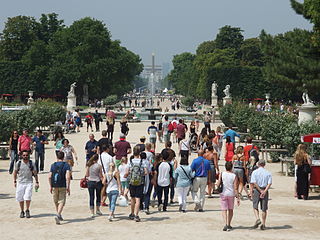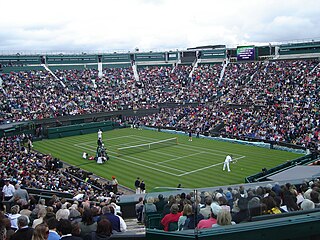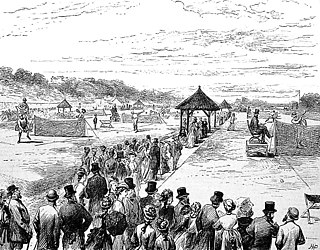Related Research Articles

Aristide Joseph Bonaventure Maillol was a French sculptor, painter, and printmaker.

On 20 June 1789, the members of the French Third Estate took the Jeu de Paume Oath in the tennis court which had been built in 1686 for the use of the Palace of Versailles. Their vow "not to separate and to reassemble wherever necessary until the Constitution of the kingdom is established" became a pivotal event in the French Revolution.

Jeu de paume, nowadays known as real tennis, (US) court tennis or courte paume, is a ball-and-court game that originated in France. It was an indoor precursor of tennis played without racquets, and so "game of the hand", though these were eventually introduced. It is a former Olympic sport, and has the oldest ongoing annual world championship in sport, first established over 250 years ago. The term also refers to the court on which the game is played and its building, which in the 17th century was sometimes converted into a theatre.

Real tennis – one of several games sometimes called "the sport of kings" – is the original racquet sport from which the modern game of tennis is derived. It is also known as court tennis in the United States, royal tennis in England and Australia, and courte-paume in France. Many French real tennis courts are at jeu de paume clubs.

The Tuileries Garden is a public garden between the Louvre and the Place de la Concorde in the 1st arrondissement of Paris, France. Created by Catherine de' Medici as the garden of the Tuileries Palace in 1564, it was opened to the public in 1667 and became a public park after the French Revolution. Since the 19th century, it has been a place for Parisians to celebrate, meet, stroll and relax.

Jeu de Paume is an arts centre for modern and postmodern photography and media. It is located in the north corner of the Tuileries Gardens next to the Place de la Concorde in Paris. In 2004, Galerie Nationale du Jeu de Paume, Centre national de la photographie and Patrimoine Photographique merged to form the Association Jeu de Paume.

Pierre Etchebaster was a French real tennis player,, the original racquet sport from which the modern game of lawn tennis is descended.

The Queen's Club is a private sporting club in Barons Court, West Kensington, London, England. The club hosts the annual Queen's Club Championships men's grass court lawn tennis tournament. It has 28 outdoor courts and ten indoor. With two courts, it is also the national headquarters of real tennis, hosting the British Open every year excepting 2020 due to the coronavirus pandemic. The Queen's Club also has rackets and squash courts; it became the headquarters for both sports after the closure of the Prince's Club in 1940.
Peter Campus, often styled as peter campus, is an American artist and a pioneer of new media and video art, known for his interactive video installations, single-channel video works, and photography. His work is held in the collections of numerous public institutions, including The Museum of Modern Art, Whitney Museum of American Art, Solomon R. Guggenheim Museum, Hamburger Bahnhof - Museum für Gegenwart, Tate Modern, Museo Reina Sofía, Albright-Knox Art Gallery, Walker Art Center, and the Centre Georges Pompidou. The artist works on the south shore of Long Island.

Valencian pilota is a traditional handball sport played in the Valencian Community. Its origins are not known.

The racket sport traditionally named lawn tennis, invented in Edgbaston, Birmingham, England, now commonly known simply as tennis, is the direct descendant of what is now denoted real tennis or royal tennis, which continues to be played today as a separate sport with more complex rules. The first Lawn Tennis Club and tournament was held in Royal Leamington Spa on 1 August 1882.

The 1877 Wimbledon Championship was a men's tennis tournament held at the All England Croquet and Lawn Tennis Club in Wimbledon, London. It was the world's first official lawn tennis tournament, and was later recognised as the first Grand Slam tournament or "Major". The AEC & LTC had been founded in July 1868, as the All England Croquet Club. Lawn tennis was introduced in February 1875 to compensate for the waning interest in croquet. In June 1877 the club decided to organise a tennis tournament to pay for the repair of its pony roller, needed to maintain the lawns. A set of rules was drawn up for the tournament, derived from the first standardised rules of tennis issued by the Marylebone Cricket Club in May 1875.
Vane Hungerford Pennell was an English rackets and real tennis player who competed in the 1908 Summer Olympics for Great Britain.

Willem van Oldenbarnevelt, Lord of Stoutenburg was a son of Johan van Oldenbarnevelt. He was born in The Hague, where he was baptised at the court-chapel in November 1590.

The Tennis Court Oath is an incomplete painting by Jacques-Louis David, painted between 1790 and 1794 and showing the titular Tennis Court Oath at Versailles, one of the foundational events of the French Revolution.

Follis, or Ball of wind, a term used in the 15th and 16th centuries in Spain and Italy, was a hollow ball, inflated with air under pressure, which allowed the ball to jump and bounce when impacting at a certain speed with any solid body. The different types of balls of wind were commonly used to play a variety of ball games that were popular on that particular period of time.

William Marshall Cazalet was a wealthy British landowner who represented Great Britain at the 1908 Olympic Games in jeu de paume.
Edwin Anthony Biedermann was a British sportsman who represented Great Britain in jeu de paume at the 1908 Summer Olympics.
The 2018 Real Tennis World Championship was a real tennis tournament held at the Queen's Club in London, England. 12-time world champion Rob Fahey regained the world title defeating the defending champion Camden Riviere by a score of 7–5.
References
- 1 2 3 "CHARLES DELAHAYE, "BIBOCHE"". Christies.com. Retrieved February 26, 2024.
- 1 2 "Real Tennis Print, Charles Delahaye". sportantiques.co.uk. Retrieved 2024-02-27.
- ↑ "Antique Real Tennis Print, Charles Delahaye, Biboche". 1stDibs.com. Retrieved 2024-02-27.
- ↑ Baillie Noel, Evan; Oscar Max Clark, James (1924). A History of Tennis. Vol. 2. Oxford University Press. p. 505. ISBN 9780598526472.
- ↑ Marshall, Julian (1890). Tennis, rackets, fives. Bronisława Czecha (Kraków): Akademia. p. 14.
- ↑ Seddon, Peter (2016). Tennis's Strangest Matches: Extraordinary but true stories from over five centuries of tennis. HarperCollins Publishers. ISBN 9781910232958.